Ganesha Worship
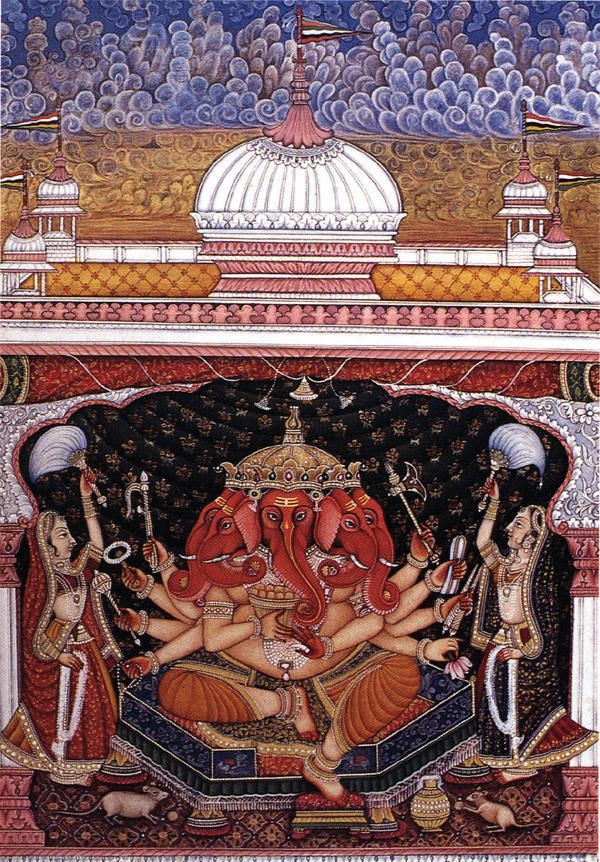
LOVE AND JOY COME TO HINDU FAMILIES WHO worship Lord Ganesha in their home through the traditional ceremony known as puja. By means of such sacred rites and the divine energies invoked, each family makes their house a sacred sanctuary, a refuge from the concerns and worries of the world. Pujas can be as simple as lighting a lamp and offering a flower at the Lord’s holy feet; or they can be elaborate and detailed, with many chants and offerings. The indispensable part of any puja is devotion. Without love in the heart, outer performance is of little value. But with true devotion, even simple gestures are sacred ritual. In this chapter we present a simple puja that anyone desirous of invoking our loving Ganesha can perform. Sanskrit and English are given here, but the latter can easily be translated into your own native language. All family members should understand the meaning of the rites. Sanskrit should not become a barrier to performing Ganesha puja. After all, He understands all dialects. One need not be initiated to perform this puja invoking our Loving Ganesha. All that is required is that the celebrant believe in the laws of karma and reincarnation, which are the cornerstones of Hindu ethical and philosophical doctrine. Ganesha worship is enjoyed by all, Hindus and non-Hindus alike, as He is the first God to be worshiped. It is not wise for an ardha-Hindu, or half Hindu, to centralize worship on Siva or Murugan or other Gods until full commitment has been made through receiving the traditional sacraments, called saµskaras. Home puja is performed at least once a day, usually in the early morning. It is traditional to not partake of food at least three hours before puja, so puja is usually done prior to meals.
The Sanctity of the Home Shrine
All Hindus attend puja at their local temple at least once a week and maintain a sacred shrine at home, which esoterically functions as an extension of the temple. The shrine room is meticulously cared for and not used for purposes other than worship, prayer, scriptural study and meditation. Here puja, home liturgy, is performed daily, generally by the head of the house. All members of the family attend.
Creating a home shrine is not difficult. The altar should be close to the floor, since most of the puja is performed while seated, or when there are small children in the home it is often higher, out of their reach. For a Ganesha shrine, an image, or murti, of Lord Ganesha is placed at the center of the altar. A metal or stone image is best, but if not available there are two traditional alternatives: 1) a framed picture, preferably with a sheet of copper on the back, or 2) A kumbha, which is a symbol of Ganesha made by placing a coconut on a brass pot of water with five mango leaves inserted between the coconut and the pot. The coconut should be husked but still have the fibers on the top. (See illustration on p. 224.) Bathing the God’s image, or murti, is part of the puja. For this, special arrangements may need to be made. Most simply, the murti may be placed in a deep tray to catch the water. After the bath, the tray is removed and the murti dried off, then dressed and decorated. More elaborately, a drain may be set up so the water flows into a pot at the side of the altar. This blessed water is later served by the pujari, who places a small spoonful in each devotee’s right palm.
Puja implements for the shrine are kept on a large and ideally metal tray. On it are arranged ghee lamps, bells, cups, spoons and small pots to hold the various sacraments.
The Necessary Items for Ganesha Puja
These items can be found in Indian stores and are specifically intended for use in religious rituals, with no other purpose or use.
1. Two water cups and a small spoon for offering water;
2. A brass vessel of unbroken, uncooked rice mixed with enough turmeric to turn the rice yellow;
3. A tray or basket of freshly picked flowers (without stems) or loose flower petals;
4. A standing oil lamp, dipastambha, which remains lit throughout the puja; ideally kept lit through the day.
5. A dipa (lamp with cotton string wick) for waving light before the Deity;
6. A small metal bell, ghanta;
7. Incense burner and a few sticks of incense, agarbhatti;
8. A container of holy ash, vibhuti;
9. A small vessel of sandalwood paste, chandana;
10. A small container of red powder, kunkuma;
11. Naivedya, fresh fruit and/or a covered dish of freshly cooked food (most often rice) to offer the Deity;
12. A camphor (karpura) burner for passing the sacred flame before the God at the height of the puja.
13. Additional items may include: small Indian pots for bathing the murti, colorful clothing for dressing the murti, garlands and additional oil lamps to light and decorate the room, and a CD or tape player.
Preparations for Commencing Ganesha Puja
Before entering the shrine room, all attending the ceremony bathe, dress in clean clothes and bring a small offering of flowers or fruit (prepared before bathing). It is traditional for women during their monthly period to refrain from attending puja, entering the shrine or temple or approaching swamis or other holy men. Also during this time women do not help in puja preparation, such as picking flowers or making prasada for the Deity. At this time of retreat, ladies are allowed to rest and perform private sadhanas, such as hatha yoga, japa, pranayama, meditation and reading the holy texts.
This same rule applies to men or women with injuries that are in the process of healing; minor scratches are excepted. Cuts and injuries that bleed, internal bleeding and operations create psychic openings in the pranic aura that render the worshiper vulnerable to intrusion from lower astral Naraka denizens, who may enter or draw out energy and do damage with that energy. The period of retreat extends until the bleeding stops and there is no more danger of infection. A minor cut or scratch may reach this point within a few hours. A deeper cut will generally take two or three days to knit to the point that no restriction is required. A severe wound may take ten days or longer. A major operation, such as heart surgery, caesarean section or appendicitis, might require several weeks or even longer, until the person feels whole again. This means that you do not go to a Hindu temple to get healed from injuries such as these, though loved ones can go to pray on your behalf.
When I was in Jaffna in 1948 and 1949, living as a guest in the homes of strict Saivite Hindus, I was impressed that they had a small house made of thatched cajan at the far end of the family compound where the women of the household went for three or four days or more each month until their period was over. During this time they did not cook for the family or perform any of their regular duties. They had a time of complete solitude. No conjugal relations were engaged in during that time. Before reentering the family home, clothing and cloth that had blood on it were burned. Women bathed, donning new clothes when they were ready to return to the home, shrine room and normal duties. This all made a strong samskara, a deep impression, on my mind. The same custom was followed by the Hawaiians and other ancient ethnic communities. The custom protects the temple from asuric intrusion.
There is another important form of retreat followed by all knowledgeable Hindus. I have codified this restriction in sutra 269 of Living with Siva: “Siva’s devotees must observe a period of thirty-one days following the birth or death of a family member during which they do not enter temples or home shrines, perform worship rites or attend auspicious events.” Japa and other personal sadhanas can and should be continued during this time. The judgment of who is part of the family rests on the shoulders of the family itself.
During festivals and special pujas it is customary to decorate the offering tray, altar and shrine room with sugar cane stalks, whole saffron plants with root attached, coconuts and banana leaves or even whole banana trees. Every variety of fruit is acceptable, notably bananas, mangos, limes, pomegranates and jackfruit. The elephant comes from the forest, and so the elephant-faced Deity’s temple or shrine is made to look like a small forest on festival days sacred to Him. Of course, modaka balls and other sweets are Lord Ganesha’s favorite treat.
Thiru M. Arunachalam provides some insights into Ganesha’s most traditional flower offerings: “In the matter of floral worship, two articles are considered very important to Ganesha. One is the aruhu grass blade. The tip of the grass shoot is collected in sufficient quantities for floral archana [chanting the names of the Lord while offering flowers]. Aruhu is the most common grass, a weed in the cultivated gardens. It is the common hariali grass (durva in Sanskrit and botanically Cynodon dactylon). It is generally collected for worship with three blades or five blades. Sometimes it is made into a wreath and placed on the shoulders of Ganesha. The second is the erukku (Calotropis) flower…. Erukku flowers are stringed together and placed round the crown and neck of Ganesha” (Festivals of Tamil Nadu, p. 117).
Instructions for Puja
In performing the puja, preparation is of utmost importance – gathering flowers, cleaning the altar and puja tray, making ready the oil lamps and preparing the fruit and/or cooked food offering. It is common to chant the 108 or 1,008 holy names of our loving Ganesha or to softly sing devotional songs while performing these tasks. This quiets the mind of the devotees and brings their awareness close to Him. Indeed, all this preparation is an integral part of worship.
Before beginning the puja, check the altar to make sure all necessary articles are there — for having to get a missing item later would disrupt the flow of puja. Hold the attitude that, as pujari, you are a servant of the Gods, a channel for the spiritual energies. Only thoughts of God are on your mind as you perform puja, thus allowing the outpouring of Divine blessings.
All items are arranged the same way for each puja so they can be reached automatically when needed, with those most frequently used closest to hand. Tradition provides a caution: you should never perform puja during or shortly after experiencing anger, deep emotional upset or crying, but it would be all right to attend. Puja is a yoga, or link, between this and inner worlds. Therefore, you must be at your best in mood and emotion to assist in making this connection. Before performing puja you should be freshly dressed, clean and undistracted by daily concerns. Having bathed beforehand, enter the shrine room and prostrate, this being the only time you prostrate until the conclusion of the puja.

The form of prostration differs for men and women. Men perform “eight-limbed obeisance,” ashtanga pranama, a fully prone pose in which hands, chest, forehead, knees and feet touch the ground. Women perform “five-limbed obeisance,” panchanga pranama, a kneeling pose in which hands, head and legs touch the ground (with ankles crossed, right over the left). Another term for prostration is pranipata, “falling down in obeisance.”
When everything is ready, take your seat in a cross-legged posture (never kneeling) in front of and to the left of the altar (or on the Deity’s right), facing the Deity but turned slightly to the right. Close your eyes, sit quietly for a moment and tune your nerve system to God Ganesha and the sacred puja you are about to perform. If others are attending your puja, be careful not to sit directly in front of the Deity, thereby blocking their view of the altar. Generally one remains seated throughout the ritual, though in some shrines it may be more comfortable to stand during the arati or throughout the puja. When small children are in the home, the shrine room is locked so they do not disturb the contents. If a lockable room is not available, the altar is raised so as to be out of reach, and the puja is performed standing up. Those attending will usually sit during most of the ceremony, then stand during the main arati. However, this again may be left to individual discretion in consideration of the height of the shrine.
During the ritual, you will be making many offerings to the God. All offerings are made with the right hand, never the left, though there are occasions when both hands are used and the left hand is held under the right hand, as if supporting it. When done correctly, this makes a beautiful gesture of sincere offering.
The offering of food is an important part of puja. Traditionally a simple dish of cooked rice is prepared especially for the Deity, with cooking utensils reserved for this purpose alone. If cooked food is not offered, then freshly cut fruit may be substituted. Keep the offering covered until the point in the puja when the pranas (life energies) of the food are offered to the Deity. Keeping the food covered helps to preserve purity and contain the pranas, which the Gods and devas can see and absorb and enjoy and reflect back into the auras of devotees to cleanse them. After the puja, the food offerings — along with holy ash (vibhuti), sacred water (tirtha), sandalwood paste (chandana), red powder (kunkuma) and flowers (pushpa) — are passed out and enjoyed as prasada.
A recording of sacred chanting from the Vedas is played softly before the puja. At the high point, as the arati is presented, loud drums and nagasvaras resound. As the sacraments are passed out by the pujari, the divine ragas are heard softly played on the vina as everyone enjoys quiet meditation, internalizing their worship.
After the sacraments are passed out, ask everyone present to chant Aum three times and then to sit quietly and internalize worship on God within them. Externalized worship traditionally is followed by internalized worship in the Siddhanta tradition. This is because all the pranas invoked during the puja must be transferred into the devotees. This is accomplished by japa yoga, which quiets the external mind and brings one into a state of meditation, awareness aware of itself without distraction. This simple practice of mentally chanting Aum many, many times followed by a period of meditation and self-reflection alone makes devotees strong enough to face the external world with enhanced willpower, true confidence and a heart filled with love, realizing that we are truly one world, one family.
Visualize Ganesha sitting on the muladhara chakra, Murugan on the manipura and Siva on the sahasrara chakra. This chakra bhakti makes worshipers strong and prepares them inwardly to face with confidence the karmas of the day. Encourage everyone to sit quietly for a while to enjoy the shakti of the sannidhya, the ever-present feeling of the Divine, that the God, Gods, inner-plane gurus and devas suffuse in the shrine room. For during the puja, you and all attending had lost physical, emotional and intellectual consciousness, having been so intently focused upon the God you were devotionally invoking. Now everyone should be encouraged by you to turn awareness within to the true Self. While holding within your mind the image of the God you have been worshiping, become conscious of the God Consciousness of the energy of all your bodies, of the movement of the breath, of the light that lights your thoughts, of the divine energy that pervades the universe, and of the high-pitched “eee” sound that is heard ringing in the head like a million temple bells. Intuit these five as coming directly from God within. When you have experienced all these at at the same time, you have attained the five-fold God consciousness.
Internalizing worship in this way gives you and all members of the family strength to face the outside world, its daily challenges and, yes, school tests. Internalizing worship is the core of the Sanatana Dharma. It is the root, stem and blossom of the highest chakra, the 1,000-petalled lotus. It is the force that gives the strength to resist temptation, to turn others from their bad ways and to face up to and live through birth karmas, prarabdha karmas, that are brought with you in this life. It gives the courage to resist making new, especially unwanted, karmas to be faced at a later date. It gives the willpower needed in this Kali Yuga to survive. It gives the love which provokes the understanding to overlook and forgive, then forget. Finally, internalized worship gives the peace of mind, the shanti, in which all saints, sages, mahatmas and great seers dwell, in their jnana of how things work in their universe of which we are a vital part.
The Ganesha Puja presented on pages 227-259 consists of several chants to be intoned while performing the indicated actions and visualizations. Each chant is given in three forms, first in devanagari script, second in transliterated English, and third in a freely-rendered English translation. To the left of the transliteration are brief procedural cues. Each translation is followed by more detailed explanations.
There are few restrictions on the performance of the puja to Loving Ganesha. There are more temples, roadside and home shrines to Him than to any other of the 330 million Gods in the pantheon of Sanatana Dharma. He understands life as it is. Fathers, mothers, children, grandparents, widows, divorcees and divorces all may perform His worship in home shrines where no yantra has ceremoniously been installed through the traditional balasthapana ceremony. He knows the world and all its worldliness. He enjoys the worship of His devotees. Although Himself a shakahari, that is, a vegetarian, He gladly accepts even the worship of devotees who include meat, fish, fowl, eggs or bugs in their diet at home. He is literate in every language of the world at any given time, but loves those unknowing of languages no less than those who are multilingual. Even though He is a virgin, He welcomes the worship of those who have enjoyed the specious pleasures of promiscuity. He, our loving Ganesha, is the God of humans and all sentient beings. But beware, He will guide them slowly in inscrutable ways. The “druggies” will become drugless, the mansahari, meat eaters, will become “veggies” and none will ever know what happened. He will prick their conscience so that guilt comes up and lift their soul to heights sublime. Therefore, even if you do not know Sanskrit, His favorite language among all His other favorite languages, you may perform this worship to Him in English or in any other language it would be easily translated into, and He will hear. Yes, He will hear.
The chants of the simple Ganesha puja given here are in Sanskrit, Hinduism’s ancient scriptural language. How well you pronounce Sanskrit depends entirely on how well you learn the 48 basic sounds of the alphabet. No amount of memorization or practice of the puja verses alone will take the place of learning the alphabet, because without mastering the sounds, your chanting will not be perfect. Time spent mastering the pronunciation is time well spent. You will then be able to read and chant the verses properly. The best way to approach the study is through learning to read the Devanagari, the Sanskrit script, because it most perfectly conveys the nuances of the language. However, many people find the chants more approachable in the transliterated English. A key to Sanskrit pronunciation for the transliteration system used in this book is given on page 436.
An additional word here about those refined souls who have guided the worshipful ways of Hindus for so many centuries may be useful. Our priesthood in Hinduism are trained from birth to be exceedingly loving, very generous and gently humble. They live, as they are taught, an unworldly existence; and there are some people, sad to say, who take advantage of their unassuming ways. Our priests are raised as children in ancestral schools called pathashalas. All temples throughout the world have priests who are well trained in performing the arts of Parartha Puja (temple liturgy), consecration of temples, samskaras (sacraments), home blessings, purification of new properties and more.
These priests, when approached in the proper attitude, will be happy to teach you the Sanskrit alphabet and how to perform this Ganesha puja properly. Most if not all will say their service is freely given and they expect nothing. But by tradition it is the duty of the recipient to give a dakshina, gifts from you periodically as your study progresses and a larger one at the end, which is mandatory. However, the priest has been trained to say no three times and then accept in great reluctance. Just because he says no once or twice does not mean that you can keep your gift and go home with it.
This protocol must be gone through. A subtle way is to give a fruit offering with a gift of money in an envelope tucked in among the fruits. He will readily accept the tray and offer the fruits to the God and keep the envelope for himself as his dakshina. Culturally, this refined mode of compensation is very different from hiring and paying a salary to a person. The Indian spiritual tradition avoids the sense of employer-employee relationship in an attempt to keep the relationship highly spiritual, elevated beyond the business of the day. Knowing this, it becomes the responsibility of the community to generously compensate priests. The unfailing law of karma will eventually pay everyone back double what they gave.
This dakshina is an important part of their livelihood. As a practical guideline, the amount should be pro-rated according to how many hours they have served or taught you. The per-hour rate must be comparable to the pay rate of any other highly skilled person within your community. It is not, for instance, equitable to pay a small pittance in U.K. pounds with the explanation that this is more than the priest would make in Madras. Service in the U.K. is rightly given in accordance with British wages, not wages in India.
It should be very clear that priests are not the servants of the devotees or of temple managers. Their knowledge, their skills and their spirit of devotion are what attract devotees to the temple. Imagine a temple with no priest in it. It would be a silent museum or art gallery — nothing more. As temple managers never want to experience the wrath of angry priests, they treat God’s servants with reverance and respect. There is a white magic that happens during puja that no one can really explain. It is a parapsychology that takes place beyond the boundaries of the intellect. Priests brought up in loving and kindly ways, who have never had to succumb to corporal punishment, perform the best. Those who have been abused and are vunerable to angry moods are capable, when driven to it by employers, of turning their talent toward the blacker arts and invoking asuric forces when performing the exact same pujas while in an angry, lower state of mind. Many newly founded temples in the West have painfully experienced this phenomenon time and again.
VIBHUTI, HOLY ASH
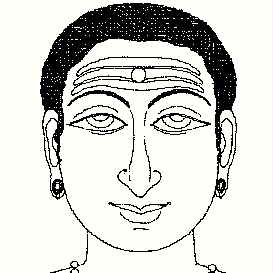
Holy ash, vibhuti, connotes purity and is a reminder to us of life’s precious transitoriness. It is prepared by burning cow dung into a whitish ash. An essential sacrament at Saiva puja, men wear it as the tripundra, a sectarian mark of three lines across the forehead, signifying the burning away of pasha — the bonds of anava (veil of duality), karma (effects of past deeds) and maya (the world). Women often wear a light film of ash across the forehead. Seen from devonic realms, holy ash has a bright phosphorescent glow, and wearing it helps the devas and the Deities see devotees more clearly.
POTTU OR BINDU, THE FOREHEAD DOT
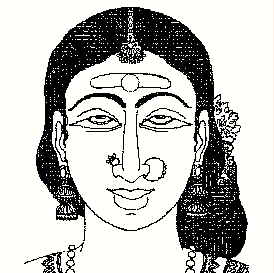
The bindu, “dot,” worn between just below the middle of the forehead, identifies one as a Hindu. It is made of red powder (kunkuma), sandalpaste, clay, cosmetics or other substances. Mystically it represents the “third eye,” our inner, superconscious vision, which sees what the physical eyes cannot see, reminding us to cultivate our higher spiritual faculties and insight. The bindu (pottu in Tamil) is also a beauty mark for Hindu women, the color red generally a sign of marriage. Unmarried women usually wear a small black pottu with a short horizontal stroke of vibhuti just above.
TEMPLE OFFERING TRAY
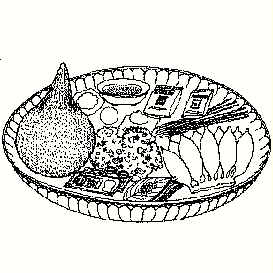
When going to a temple to attend puja, devotees bring a sacred offering tray or basket. The offerings can be prepared at home or sometimes purchased in small stalls near the temple entrance. Traditionally, the offerings include: 1) a fresh, husked coconut; 2)a garland of fresh flowers; 3) a few sticks of incense; 4)fresh fruits, e.g., banana, lime, mango; 5) a package of vibhuti (holy ash); 6)Êkunkuma (red powder); 7)sandalwood powder; 8) a packet of camphor; 9)a small bottle of rosewater; 10)a modaka or other sweet (optional); 11)and a financial contribution for the temple or its priests.
PRADAKSHINA, CIRCUMAMBULATION
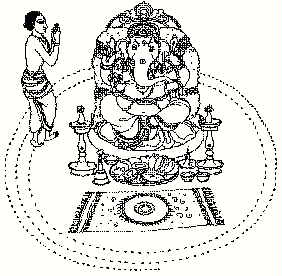
Before worship, and sometimes during the puja, we walk three times around the Deity, the shrine or the temple. This is called pradakshina, “right-facing,” referring to keeping the Deity to our right by walking clockwise, never counterclockwise. By this custom we deliberately withdraw our awareness from worldly matters and direct it toward the Divine. As we circle the God, subtle psychic worldly bonds that naturally accumulate during the day in the human aura are broken. Thus, circumambulating the Lord three times brings us into a pure, one-pointed, worshipful state of consciousness.
SHANKHAPRAHATI, KNOCKING THE TEMPLES
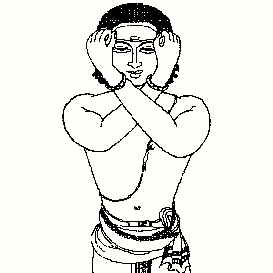
When worshiping Lord Ganesha, standing before His shrine, devotees may tap the temples gently three times with the knuckles, fists closed and arms crossed in front of the face. Esoterically, this action is said to stimulate certain nerves within the head to catalyze the flow of amrita (nectar) from the sahasrara chakra at the crown of the head, giving abhisheka (ritual bath) to Lord Ganesha, Who sits on the muladhara chakra at the base of the spine. It is a gesture of submission, beseeching forgiveness for errors, remembrance of Ganesha’s presence and supplication of the grace of this loving God.
PALIKARSHA, PULLING THE EARS
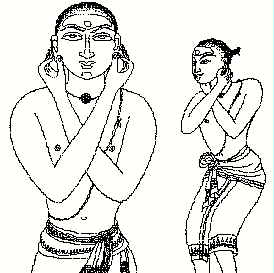
After knocking the temples lightly, devotees will often pull gently on the ear lobes with arms crossed, while bobbing up and down by bending the knees and bowing forward slightly. This rather humorous gesture is an expression of humility, a recognition that all souls are children in the eyes of God. Pulling the ears is done to draw Lord Ganesha’s loving attention to His self-effacing, self-erasing servant and submission of transgressions at His holy feet. Mystically, it stimulates important nadis, inner nerve currents to help internalize awareness for ritual worship, puja, and meditation, dhyana.
GANAPATI KALASHA – WATER POT AND COCONUT
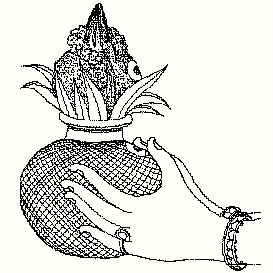
The kalasha (or kumbha), a water pot topped with mango leaves and a husked coconut, may represent the Deity on home altars and at special temple pujas. Coconuts are especially sacred to Lord Ganesha, and many are broken and offered at His temples and shrines. Breaking a coconut during prayer symbolizes the shattering of the ego, which must be surrendered lest it obstruct true worship through its desires and intrigues. Breaking the coconut’s rough, hard shell to reveal the ripe fruit within is likened to shattering our brittle shell of ignorance to reveal the sweet spiritual truths inside.
HUNDI: THE TEMPLE OFFERING BOX
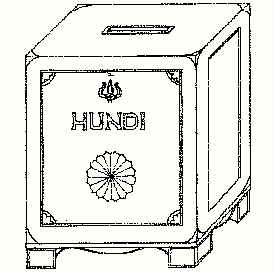
In the Hindu temple there is always a small or large strongbox into which devotees may offer a sacrifice to perpetuate the temple and its charitable works. When our prayers are answered, when God has shown us His grace and we seek to support His home on Earth, we place money or other valuables, such as jewels, gold and silver, into the hundi. In many temples, the donations are counted before the Deity each evening. To support the priests and their families, we place a separate and usually smaller contribution, called dakshina, on the offering tray, traditionally wrapped in betel leaf.
Ganesha Puja: A Step-by-Step Guide
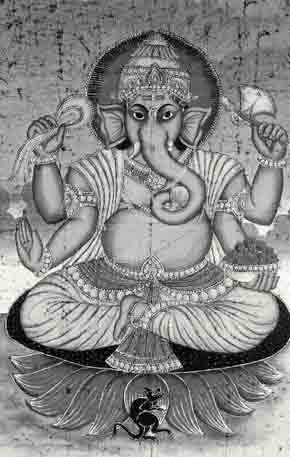
A Traditional Daily Worship Ceremony Performed in the Home Shrine to Beseech God Ganesha’s Blessings and Protection.
Achamanam: Water offering
Rinse, sip 3 times, then rinse again.
Aum sumukhaya svaha
Aum ekadantaya svaha
Aum gajakarnakaya svaha
Aum! Hail to the God whose face is always shining!
Aum! Hail to the God who has only one tusk!
Aum! Hail to the God with huge elephant ears!
Holding the spoon with your left hand, pour a spoonful of water from the cup into the right palm to rinse the hand, letting the excess fall onto the floor or a tray. Put another spoonful of water into the right hand, pronounce “Aum sumukhaya svaha” and sip the water. Repeat for the second and third lines, then rinse the right hand again as above.
Vighneshvara Prarthana: Ganesha Invocation
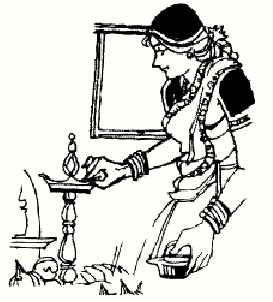
Namaskaram,
knock temples,
namaskaram.
Aum shuklambaradharam vishnum
shashivarnam caturbhujam
prasanna mattavaranah dhyayet
sarvavighnopashantaye
Aum. O Lord dressed in splendid white, pervading all the universe, shining radiantly like the ivory rays of the full moon, having four mighty shoulders and a charming, happy face. We meditate on you, Lord, that all obstacles may be quelled.
Salute Lord Ganesha on the altar by holding your hands in anjali mudra, the prayerful pose. Then, while reciting the above verse, cross your arms before your face and tap your temples lightly with your knuckles three times, the left hand tapping the right temple and vice versa. This is a traditional way of supplicating Lord Ganapati. The place to knock is the bony, protruding part toward the front. Return your hands to anjali mudra while reciting the last words of the chant.
Sankalpam: Dedication of puja and statement of purpose
Insert the appropriate period of the day in the chant below.
ushah kala, dawn
pratah kala, morning
madhyahnakala, noon
sayankala, evening
urdhvayamakala, night
Hold rice and flower in closed right hand at chest.
Aum adya purvokta evangunasakala
visheshena vishishtayam
asyam shubhatithau
Aum Maha Ganeshvara uddishya
Maha Ganeshvara prityartham
Maha Ganeshvara prasada siddhyartham
yatha shakti (chant city) deshe (insert the time of day)
Toss rice and flower.
dhyanavahanadi Ganesha pujam karishye
Rinse hands.
Aum apa upasprishya

Now, at this particularly auspicious moment, time and place, on this wholly auspicious day, so that we may realize the fullness of Your grace, to the best of our ability this (insert time of day) Ganesha puja we shall now perform. Aum. By touching pure water we become pure.
While reciting the above statement of purpose, take a pinch of rice and hold it in your closed right palm at chest height. Depending on when you are performing the puja, insert the time of day where indicated. As you chant the last word, karishye, gently toss the rice toward the base of the image. Then, with the left hand, place a spoonful of water into the right palm, return the spoon to the cup and ritually wash both hands with the water by wiping the palms together a few times as you recite “Aum apa upasprishya.” Once the sankalpam has been chanted, the puja must not be interrupted or abandoned until the concluding mantras are recited.
Dhyanam: Meditation
Offer rice three times.
dhyayami
avahayami
ratnasinhasanam samarpayami
We now meditate on Lord Ganesha. In all splendor we have prepared for You a jewel-studded, lion-footed throne to sit upon, Lord Ganesha.
Offer a pinch of rice to the Deity as you chant each line of the above meditation and invocation. Visualize God Ganesha seated on a golden throne before you, smiling, full of blessings, waiting to be honored as a guest in the home of His devotee.
Arghyam: Bathing the feet and hands of God Ganesha
Offer water two times into the tirtha cup.
padayoh padyam
padyam samarpayami
hastayoh arghyam
arghyam samarpayami
We now humbly bathe each of Your white lotus feet and gently wash each of Your precious hands, Lord Ganesha.
With your right hand offer a spoonful of pure water by holding it up before the Deity momentarily and then placing it in the tirtha cup. This is how all water offering is done throughout the puja. As you chant the first line, visualize yourself bathing the feet of Ganesha. Offer a second spoonful of pure water as you intone the next line and visualize yourself washing His hands.
Achamanam: Offer water
Aum bhur-bhuvah suvah
achamaniyam samarpayami
Aum! In the presence of all three worlds, O Lord Ganesha, we humbly offer You fresh, pure water for sipping.
Offer a spoonful of pure water to Ganesha. This time visualize Him accepting it in His Hand and sipping it.
Abhishekam: Bathing the Lord with pure water
Ringing bell, hold flower and sprinkle murti.
Aum surasindhu samanitam
suvarnakalashasthitam |
snanartham grihyatam shambho
Set bell down.
salilam vimalam Ganesha ||
We now bathe You, beloved Lord, the pure one, with the water present in the golden pot brought from Ganga through akasha, space.
While ringing the bell and reciting this auspicious, purifying hymn, dip a flower into the tirtha water and gently sprinkle the Deity. Do this three times or more. Hold the flower in your right hand in the mrigi mudra, the stem between your third and fourth fingers. If the altar design allows, you may pour water over the murti rather than sprinkling it during this chant.
Alankaram: Adornment and prayer for prosperity
Adorn the Deity with flowers, garlands, clothing and jewels.
Aum gandham grihana surabhi
mandhakasurasudana,
kunkumadi samayuktam
kulachalaniketana
(repeat while decorating)
Apply vibhuti, sandalwood paste and kunkuma.
divya parimala vibhuti
chandana kunkumam samarpayami
Aum. O thou Lord Ganesha, son of Lord Siva who defeated the demon Andhakasura. Hail to Him who resides at the Himalayas. Now we anoint You with divine and supremely pure white vibhuti, exceedingly fragrant sandalwood paste and red, red kunkuma.
During this chant, decorate the murti or picture and adorn it with the traditional puja sacraments. The first four lines of the verse may be repeated again and again until the adornment is completed. The last two lines are recited once while applying vibhuti (holy ash), chandana (sandalpaste) and kunkuma (red powder).
Mangalakshatan: Offering rice and flowers
Offer rice, then flower(s) or more rice.
tadupari mangalakshatam samarpayami
pujarthe nanavidhapatra
pushpani samarpayami
We now offer this auspicious unbroken rice. And for the fulfillment of our devotion, we offer fresh, blooming flowers for Your enjoyment, our peerless Lord.
A pinch of rice is offered with the first line. A handful of flowers, a single flower or a pinch of rice is offered with the second.
Dhupam: Offering Incense
Ringing bell, pass incense in 3 circles, then trace Aum with light (in Sanskrit, Tamil, Gujarati, etc.)
Aum vanaspatyudbhavaih divyaih
nanagandhasamanvitaih,
aghreyadhupadipanam
dhupo-yam pratigrihyatam.
dashangam guggulopetam
sugandham sumanoharam,
aghreyah sarvadevanam
dhupo-yam pratigrihyatam.
Ring bell loudly.
dhupamaghrapayami
Offer water.
dhupanantaramachamaniyam
samarpayami
Offer rice.
mangalakshatan samarpayami
The finest incense, of magical qualities, of full and varied fragrances, for Your enjoyment, Lord Ganesha, we set aflame and offer to You in this, our home. This fine incense we have duly offered for Your pleasure. And in the proper order, we again offer You cool, sweet water for sipping and auspicious unbroken rice.
During the above chant, make three circles before the Deity with lighted incense held in the right hand while ringing the bell with the left hand. With practice, you will complete the third circle as you chant the fifth line, dhupamaghrapayami. At that point the incense is raised higher and the bell rung louder. Putting the incense down, the next two lines are recited. With the first, water is offered; with the second, a pinch of rice.
Dipam: Offering the Light
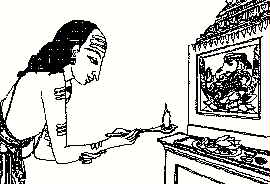
Part One: Ring bell, pass lamp in 3 circles, then any Aum.
Aum sajyamtrivarti samyuktam
vahnina yojitam maya
grihana mangalam dipam,
isha putra ganadhipam.
Part Two: optional
uddi”pyasva jatavedopaghnan nirritim mama, pashugushcha (pashungshcha) mahyamavaha jivanan cha disho dasha,
ma no higumsijjatavedo (hingsijjatavedo) gamashvam purushanjagat,
abibhradagna agahi shriyama paripataya.
Ring loudly.
divya mangala dipam sandarshayami
Offer water.
dipanantaram achamaniyam
samarpayami
Offer rice.
mangalakshatan samarpayami
Within fire is spiritual knowledge, our refuge. Because of it, no harm can befall us. In our home, cows are honored and highly respected, which enlivens the nations in all directions. Let us not forget right knowledge, culture and religious rites, O matchless Lord! Nor may any soul living in this world so forget! Spreading before and around us, purity and peace abound, as this holy flame illumines all with clarity. This divine flame we have shown You, Lord Ganesha, and dutifully, in proper order, that all may receive Your grace, we again offer You cool, sweet water for sipping and auspicious unbroken rice.
Offer the oil light to Ganesha and ring the bell as you chant this Vedic hymn. As with the incense, circle three times, then draw the Aum with the flame. While chanting the line beginning with divya, raise the flame and ring the bell more loudly, then stop ringing. With the last two lines, offer water, then a pinch of rice or a flower.
Naivedyam: Food offering
Ring bell, stop,
satyam tvartena (if morning)
ritam tva satyena (if evening)
Offer water.
parishinchami
Offer water.
Aum amritamastu
amritopastaranamasi svaha
Aum. We add Truth to Truth. Aum. May this sweet and pungent food be transformed into nectar, O Ganesha.
While reciting the first part of the mantra, uncover the food offering. Then, ringing the bell, take a spoonful of water and circle it clockwise above the food. During the second part (Aum amritamastu…), without ringing the bell, offer a spoonful of water.
Asamarpanam: Offering pranic essence of the food
Waft flower over food while chanting each line. Release flower.
Aum Ganeshaya svahA
Aum Ganeshaya svahA
Aum Ganeshaya svahA
For the above, while ringing the bell softly, gently waft the aroma and vital essences of the food or fruit toward the Deity. Do this by sweeping the right hand over the food (one wave for each prana offered) with a flower held in mrgi mudra, between thumb, ring and middle fingers, stem upward. The palm is facing downward as it moves over the food, then rotates upward as the sweep approaches the Deity, bringing the fragrance and pranas into His nose and mouth. As you complete the last line, gently toss the flower toward the feet of the Deity by releasing it at the end of the sweep with all the love in your heart.
Begging the Lord to accept our food offering
Ringing bell loudly, pick up rice or flower.
Aum avahitabhyah sarvabhyo
devatabhyo namah
Toss rice and flower, then stop ringing.
nana vidha mahanaivedyam nivedayami
yathashaktya samarpita mahanaivedyam
kripaya svikuru
Aum! Salutations to all the Gods and devas present! Because we are offering you our very best, Lord Ganesha, in all sincerity and love, the essence of this humble plate of food must be counted among the finest meals You have ever received. To the best of our ability in the worship of You, we offer the sacred essence of this food and humbly beg that You receive it.
Ringing the bell loudly as you recite the above chant, pick up a flower or a pinch of rice and hold it at chest height in the fingertips of the right hand. As the last word is spoken, gently release the rice or flower at the feet of the Deity. Then put down the bell and raise both hands above your head in devout prayer that Ganesha will accept the meal. While your hands are raised, close your eyes and hold a clear visualization of Ganesha accepting and partaking of the meal. After a moment, lower your hands and intone Aum quietly.
Vighneshvarashtottara Shatanamavalih: Chanting the 108 Names of Lord Ganesha
In this section of the puja, chant the Vighneshvarashtottara Shatanamavalih, “garland of Ganesha’s 108 names.” As you intone each name, offer with your right hand a flower, some flower petals or a pinch of rice. The names are attributes of the Deity, each one delineating an aspect of His infinite and indescribable nature. Hold the flower basket in your left hand if you are standing, and in your lap if sitting. The bell is not rung. The names may be recited at any pace, depending on your time and ability. Each name is preceded by the mantra Aum and followed by namah, meaning “obeisance, praise, adoration” or “homage” to.
1. Aum Vinayakaya Namah
Adoration to the remover (of obstacles)
2. Aum Vighnarajaya Namah
Adoration to the ruler of obstacles
3. Aum Gauriputraya Namah
Adoration to the son of Gauri
4. Aum Ganeshvaraya Namah
Adoration to the lord of categories
5. Aum Skandagrajaya Namah
Adoration to Skanda’s elder brother
6. Aum Avyayaya Namah
Adoration to the inexhaustible one
7. Aum Putaya Namah
Adoration to the pure one
8. Aum Dakshaya Namah
Adoration to the skillful one
9. Aum Adhyakshaya Namah
Adoration to the great presider
10. Aum Dvijapriyaya Namah
Adoration to Him who loves the twice-born
11. Aum Agnigarvacchhide Namah
Adoration to Him who destroyed the ego of the fire
12. Aum Indrashripradaya Namah
Adoration to the restorer of Indra’s wealth
13. Aum Vanipradaya Namah
Adoration to Him who gives the power of speech
14. Aum Avyayaya Namah
Adoration to the inexhaustible one
15. Aum Sarvasiddhipradaya Namah
Adoration to the bestower of all fulfillment
16. Aum Sarvatanayaya Namah
Adoration to the son of Siva
17. Aum Sharvaripriyaya Namah
Adoration to Him who is loved by Parvati
18. Aum Sarvatmakaya Namah
Adoration to Him who is the soul of all
19. Aum Srishtikartre Namah
Adoration to the Creator
20. Aum Devaya Namah
Adoration to the Resplendent One
21. Aum Anekarchitaya Namah
Adoration to the one worshiped by multitudes
22. Aum Sivaya Namah
Adoration to the auspicious one
23. Aum Shuddhaya Namah
Adoration to the pure one
24. Aum Buddhipriyaya Namah
Adoration to Him who is fond of intelligence
25. Aum Shantaya Namah
Adoration to the peaceful one
26. Aum Brahmacharine Namah
Adoration to Him who is celibate
27. Aum Gajananaya Namah
Adoration to Him who has an elephant’s face
28. Aum Dvaimaturaya Namah
Adoration to Him who has two mothers
29. Aum Munistutaya Namah
Adoration to Him who is praised by sages
30. Aum Bhaktavighnavinashanaya Namah
Adoration to the destroyer of devotees’ obstacles
31. Aum Ekadantaya Namah
Adoration to Him who has one tusk
32. Aum Chaturbahave Namah
Adoration to Him who has four arms
33. Aum Chaturaya Namah
Adoration to the ingenious one
34. Aum Shaktisamyutaya Namah
Adoration to Him who is united with power
35. Aum Lambodaraya Namah
Adoration to Him who has a large belly
36. Aum Shurpakarnaya Namah
Adoration to Him with ears like winnowing fans
37. Aum Haraye Namah
Adoration to Him who destroys evil with lion-like courage
38. Aum Brahmaviduttamaya Namah
Adoration to the foremost knower of the supreme God
39. Aum Kalaya Namah
Adoration to the master of destiny
40. Aum Grahapataye Namah
Adoration to the lord of all planets and galaxies
41. Aum Kamine Namah
Adoration to Him who is love
42. Aum Somasuryagnilochanaya Namah
Adoration to Him whose eyes are the moon, sun and fire
43. Aum Pashankushadharaya Namah
Adoration to the One who holds a noose and goad
44. Aum Chandaya Namah
Adoration to the One who appears fearsome
45. Aum Gunatitaya Namah
Adoration to Him who transcends qualities
46. Aum Niranjanaya Namah
Adoration to Him who is without blemish
47. Aum Akalmashaya Namah
Adoration to Him who is without impurity
48. Aum Svayamsiddhaya Namah
Adoration to Him who is self-fulfilled and perfect
49. Aum Siddharchitapadambujaya Namah
Adoration to Him whose lotus feet sages worship
50. Aum Bijapuraphalasaktaya Namah
Adoration to Him who is fond of pomegranates
51. Aum Varadaya Namah
Adoration to the bestower of boons
52. Aum Shashvataya Namah
Adoration to the eternal, unchanging one
53. Aum Kritine Namah
Adoration to the skillfully accomplished one
54. Aum Dvijapriyaya Namah
Adoration to Him who is fond of the twice-born
55. Aum Vitabhayaya Namah
Adoration to Him who is free from fear
56. Aum Gadine Namah
Adoration to Him whose weapon is the mace or club
57. Aum Chakrine Namah
Adoration to Him whose weapon is the discus
58. Aum Ikshuchapadhrite Namah
Adoration to Him who holds the sugarcane bow
59. Aum Shridaya Namah
Adoration to the bestower of great wealth
60. Aum Ajaya Namah
Adoration to the unborn one
61. Aum Utpalakaraya Namah
Hail to Him who holds the upright blue lotus flower
62. Aum Shripataye Namah
Adoration to the Lord of overflowing wealth
63. Aum Stutiharshitaya Namah
Adoration to Him who delights in praise
64. Aum Kuladribhrite Namah
Adoration to Him who supports Himalaya, His family’s mountain
65. Aum Jatilaya Namah
Adoration to Him who wears distinguished matted hair
66. Aum Kalikalmashanashanaya Namah
Adoration to Him who destroys sins in the Kaliyuga
67. Aum Chandrachudamanaye Namah
Adoration to Him who wears a moon upon his head
68. Aum Kantaya Namah
Adoration to the beloved, loving one
69. Aum Papaharine Namah
Adoration to the destroyer of sins
70. Aum Samahitaya Namah
Adoration to Him who is absorbed in meditation
71. Aum Ashritaya Namah
Adoration to Him who is our refuge
72. Aum Shrikaraya Namah
Adoration to Him who manifests prosperity
73. Aum Saumyaya Namah
Adoration to the pleasant one
74. Aum Bhaktavanchhitadayakaya Namah
Adoration to the grantor of devotees’ desires
75. Aum Shantaya Namah
Adoration to the peaceful one
76. Aum Kaivalyasukhadaya Namah
Adoration to the bestower of unsullied liberation
77. Aum Sacchidanandavigrahaya Namah
Adoration to the embodiment of Existence-Knowledge-Bliss
78. Aum Jnanine Namah
Adoration to the great wisdom
79. Aum Dayayutaya Namah
Adoration to Him who is full of compassion
80. Aum Dantaya Namah
Adoration to Him who has self-control
81. Aum Brahmadveshavivarjitaya Namah
Adoration to Him who is free from aversion to knowledge
82. Aum Pramattadaityabhayadaya Namah
Adoration to Him who brings terror to power-intoxicated demons
83. Aum Shrikanthaya Namah
Adoration to Him whose throat is beautiful
84. Aum Vibudheshvaraya Namah
Adoration to the Lord of the Wise
85. Aum Ramarchitaya Namah
Adoration to Him who is worshiped by Rama
86. Aum Vidhaye Namah
Adoration to Him who is the destiny of all
87. Aum Nagarajayajnopavitavate Namah
Adoration to Him whose sacred thread is a king cobra
88. Aum Sthulakanthaya Namah
Adoration to Him who has a stout neck, representing tremendous will and compassion
89. Aum Svayamkartre Namah
Adoration to Him who is the cause of himself
90. Aum Samaghoshapriyaya Namah
Adoration to Him who loves the sound of Sama Veda
91. Aum Parasmai Namah
Adoration to Him who is supreme
92. Aum Sthulatundaya Namah
Adoration to Him who has a stout, unpredictable trunk
93. Aum Agranyaya Namah
Adoration to Him, the first-born of Siva
94. Aum Dhiraya Namah
Adoration to the courageous one
95. Aum Vagishaya Namah
Adoration to the Lord of speech
96. Aum Siddhidayakaya Namah
Adoration to the bestower of fulfillment
97. Aum Durvabilvapriyaya Namah
Adoration to Him who loves durva grass and bilva leaves
98. Aum Avyaktamurtaye Namah
Adoration to the manifestation of the Unmanifest
99. Aum Adbhutamurtimate Namah
Adoration to Him of wondrous form
100. Aum Shailendratanujotsanga khelanotsukamanasaya Namah
Adoration to Him who is fond of playing in the lap of His mother, Parvati, daughter of the mountain Lord [Himavat]
101. Aum Svalavanyasudhasarajita manmathavigrahaya Namah
Adoration to Him who defeated Manmatha, the God of love, by His sweet beauty
102. Aum Samastajagadadharaya Namah
Adoration to the supporter of all the worlds
103. Aum Mayine Namah
Adoration to the source of illusory power
104. Aum Mushikavahanaya Namah
Adoration to Him who rides the abundance-gathering mouse
105. Aum Hrishtaya Namah
Adoration to the rapturously joyful one
106. Aum Tushtaya Namah
Adoration to the contented one who has it all in control
107. Aum Prasannatmane Namah
Adoration to the bright loving kindly-souled one
108. Aum Sarvasiddhipradayakaya Namah
Adoration to the grantor of all fulfillment
Mantra Pushpam: Blessing and worshiping with flowers
Hold a double handful of flowers or rice in Namaskaram 🙏
yopam pushpam veda
pushpavan prajavan pashUman bhavati
chandramAva apam pushpam
pushpavan prajavan pashuman bhavati
ya evam veda yopamAyatanam veda
Ayatanavan bhavati
Toss flowers over murtis.
Aum Shri Mahaganeshvaraya namah
mantra pushpanjalin samarpayami
The one who understands the beauty of the blooming Powers of the Supreme Being is blessedwith beautiful blooming life, progeny and cattle. The moon is certainly the bloom of those Powers. One who realizes the qualities of the moon, which are nothing but the blooming Divine Powers, is blessed with a blooming, beautiful life of perfection, progeny and cattle. One who realizes this principle and realizes the Source from Whom all these powers have come himself becomes the abode of those Divine Powers.
While chanting the above mantra, hold an offering of flowers before you in anjali mudra, hands cupped loosely around the flowers at chest height. If no flowers are available, uncooked unbroken rice may be offered, held in the closed right hand, palm down, supported by the open left hand. Recite the verses with adoration. As you intone the last word, samarpayami, throw the flowers into the air above the altar, sending a shower of blossoms or rice upon the God with the feeling of total release, of giving in loving devotion.
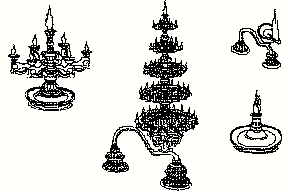
Arati
Worship with flame waving
Ringing bell, draw three circles in Aum.
Aum sajyamtrivarti samyuktam
vahnina yojitam maya,
grihana mangalaratim
Ring bell loudly.
isha putra namo-stu te.
Keep ringing loudly.
Aum avahitabhyah sarvabhyo
devatabhyo namah
divya mangaladiparatikyam
sandarshayami
Offer water.
achamaniyam samarpayami
Offer rice.
mangalakshatan samarpayami
May we pray to the Lord Ganapati: the master and protector of the noble and the righteous people, the wisest among the wise, preeminent among the renowned, the greatest ruler, protector of the knowledge of all who are knowledgeable. O Lord Ganapati, please hear our prayers and protect us with Your powers. We have prepared the best seats for You in ourselves. O, do come and grace them.
Adoration to all Gods we have invited for this puja. To them I offer this divine Light of camphor arati flame. I offer holy water for sipping and auspicious unbroken rice grains to grant me blessings.
With the above chant, hold the lit camphor burner (or oil lamp) in your right hand and the bell in your left. While ringing the bell and reciting the arati mantra, slowly make three circles clockwise before Ganesha with the flame. Stop at the top of the third circle, lower the lamp slightly and trace the symbol of Aum in Devanagari or in your native script.Then lift the flame slightly above the Aum that you placed in the akashic ether and ring the bell louder for all three worlds to hear. Keep ringing loudly while chanting the above four-line salutation to the devas (avahitabhyah…). Put down the bell and the lamp and then, with the flame still burning, offer a spoonful of water with “achamaniyam…,” then a pinch of rice with “mangalakshatan….”
Rakshadharanam: Prayer to Indra
Set lamp down, circle 3 times with flower
indra-stomena panchadashena
madhyamidam vatena sagarena
raksha raksham dharayAmi
O Indra, Lord of material and spiritual prosperity! Please protect the space between the heavens and earth as well as the mind between the body and the soul with the help of fifteen noble powers and virtues (five pranas, five jnanendriyas and five karmendriyas). The space is filled with the air and moisture, while the mind is filled with prana and devotion and love for You. I wear this garment of your protection and blessings.
As you recite this mantra, make three circles above the burning flame with a flower held in the right hand, stem upward. With the last words, toss the flower gently toward the Deity and place your hands in namaskara while facing the altar.

Now pass the flame to the others present. Offer it in front of each person at chest level. They in turn “take the flame” by passing the fingers of both hands through it and lightly touching the eyes. The Gods and devas can see us through the sacred flame and send their blessings. If any especially honored persons are present, such as one’s guru, parents or teacher, take the flame first to them. 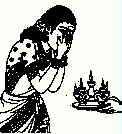
Then proceed clockwise, offering it to all others present. In some cases, the pujari may stand near the altar while devotees come forward themselves to take the blessings of the arati flame. If no one is attending the puja, then you may take the flame yourself, but not otherwise. Finally, present the flame once more to the Deity on the altar, then extinguish it with a wave of the right hand or by snuffing it out with a flower. When the flame is camphor, it is best to let it burn clean of itself.
Arpanam: Final consecration and surrender to the Lord
Five periods of the day
Chant appropriate period at line two below.
ushah kala, dawn
pratah kala, morning
madhyahnakala, noon
sayankala, evening
urdhvayamakala, night
Rice and water in hand, offer before the Deity.
anaya yatha shaktya krita
(state period of day from list above)
pujaya bhagavan sarva devatmakah
shri Mahaganeshvarah supritah
suprasanno varado bhavatu
Now to the best of our ability we have performed this (state time of day) puja and worshiped You, dear Lord, the brightest of all the Gods. May it please You. May it be enjoyed by You. Surrounded by Your presence, we place ourselves in Your care, loving Ganesha.
Before reciting the above verse, place a pinch of rice in your left palm, then immediately transfer it to the right palm. Add to the rice three spoonfuls of water and close the hand. Hold the rice before you as you face the Deity, the left hand under the right hand, and recite the mantra. As you intone the last words, let the rice and water fall into the tirtha cup. The sacraments may then be given out in the following order: vibhuti, tirtha, chandana, kunkuma, naivedya and flowers. If no one is attending the puja, you may partake of the sacraments yourself, but not otherwise. If many devotees are attending, a second person may help pass out the sacraments, except for the vibhuti which is always given by the person who performed the puja.
Visarjanam: Farewell and Apologies
Hold hands in anjali mudra. Prostrate after completing the chant.
Aum avahanam na janami na janami visarjanam
pujanchaiva na janami kshamyatam parameshvara
mantrahinam kriyahinam bhaktihinam sureshvara
yat pujitam mayadeva paripurnam tadastute
anyatha sharanam nasti tvameva sharanam mama
tasmat karunyabhavena raksha raksha Ganeshvara
Aum tat sat Aum.
O beloved Lord Ganesha, we really do not know the proper means of invoking You or communicating with You as You are. A full knowledge of priestly rites has not been imparted, so You must overlook and forgive any mistakes or omissions. We know little of mantras or pious conduct, and we are strangers to true bhakti. Nonetheless, You must forgive us and, whatsoever worship we have been able to do, accept it as exact and complete — because You are our only refuge, our loving Ganesha. With your blissful nature, Lord Ganesha, we beseech you, protect those who pray. Aum Tat Sat Aum.
This concluding apology is recited with hands in namaskaram, anjali mudra. It is a formal and devout end to the worship service. As the final words, “Aum Tat Sat Aum,” are spoken, it is customary for yourself and others present to clap the hands together softly three times. You may now prostrate. Having completed the puja, it is customary to sit in internalized worship, realizing our loving Ganesha within ourselves. To meditate for a few minutes after the puja is very traditional. There is great personal benefit in taking in to the soul level the refined feelings, the prana, that the puja has created and which still remains in the room. Externalized worship is the kriya path; internalized worship is the yoga path. Both together make the complete circle that sustains devotees in their spiritual life, making them strong and kindly in moving the forces of the world in their daily life. It is the very foundation for the final goal of all seekers: moksha, freedom from rebirth.
**Credits to and published by Himalayan Academy

